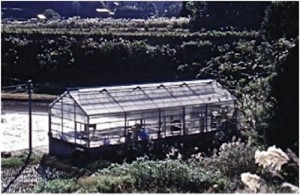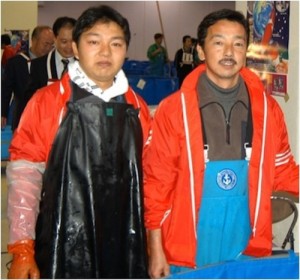Chapter Eleven.
In spring ’88 I saw the fruits of his Goshiki labours for the first time, these were small 4” tosai Sumigoromo in the main part but there were some that were true Goshiki. The problem was that the wonderful female had died through natural causes after the first spawning and he would have to wait another three years before he could grow females from the first spawning to maturity to become new female parents. These beautiful tosai were already taking awards at the shows as his words ‘Gapo Gapo’ demonstrated.
That visit was also the first time I saw reasonable sized Magoi Sanke in any real quantity and I watched as he selected nisai and sansai for his mud ponds.
Although the old style Koi looked to be exactly the same as the new style in terms of pigmentation there was a definite difference in skeleton.
After watching his selection for some minutes it became reasonably easy to differentiate the two styles, of course many of the new style Sankes gave the game away in their constant efforts to escape out of the bowls.
Right up until the mid 1990’s it wasn’t the easiest of tasks to get the Koi from Isawa to Niigata and vice-versa. The freeway and Shinkansen line had linked Tokyo to Nagaoka since 1983 but taking the road from Isawa to Tokyo and then to Niigata put a huge ‘dog-leg’ on the journey and the best option was to go in a reasonably straight line directly over the mountains to eventually get to Tsunan and then Ojiya.
There were many times I traveled with Toshio along these roads and also there were times when I’d travel down with Toshiyuki to Isawa. It did save on rail fares but the journey took over twice the time it would have taken by train on a good day, but if snows were around it could take up to 14 hours.
On one occasion I shared a truck in total silence with one of Toshio’s staff who spoke not a single word of English – it wasn’t until 1996 that I discovered who the guy was, Masaru Saito of the Shintaro Koi farm, just up the banking from Yamamatsu! At the time I met him he was doing a three-year apprenticeship with Toshio.
It wasn’t until 1995 that the freeway from Nagaoka would link Nagano to either Nagoya or Yamanashi. Today the journey can be done in four hours, that’s if the driver knows where the speed cameras are!
The journeys involved a convoy of three large trucks each with two one ton water containers and oxygen diffusion from bottles Toshio would pull over every hour to check all was working properly.
Toshiyuki and his team in Mushigame would prepare Toshio’s four main mud ponds some 8 miles north near Tochio village and the trucks would head for there irrespective of arrival time which often could be in darkness. It was usually the day after that Toshiyuki took the Yamamatsu tategoi into the same mud ponds.
It was in October 1988, just before the Matsunosuke harvests that I interviewed Toshio for inclusion in a book I had been working on since ’83. This was carried out in the Yamamatsu family home, using the gratis services of my friend Mr. Onozuka. He was the manager of the Grand Hotel in Nagaoka, his English was excellent.
It was also in 1988 that I saw Toshio’s new indoor house and mud pond just down the road from Yamamatsu, by then it was a necessity in view of the increase in production at both outlets.
 Come to think of it, from ’88 onwards, new Koi houses seemed to be springing up in all parts of Yamakoshi. Of course Dainichi was still the main name on the tongues of Koi breeders and enthusiasts but new names such as Hoshikin; Choguro; Tomezo and Maruhoshi soon became to be whispered around the mountainsides.
Come to think of it, from ’88 onwards, new Koi houses seemed to be springing up in all parts of Yamakoshi. Of course Dainichi was still the main name on the tongues of Koi breeders and enthusiasts but new names such as Hoshikin; Choguro; Tomezo and Maruhoshi soon became to be whispered around the mountainsides.
From ’89 to ’94 it was all a case of returning for many visits and endlessly studying the Koi production and to try and take in the annual increases in the quality of production. I still spent much of my time in the Koi auction houses where everyone knew me as ‘Mr. Peter’ or ‘Peter san’ simply because it was near impossible to write ‘Waddington’ in Kanji.
I have no doubt that much of my information on the Koi themselves came from Toshio, either by showing me examples of some of the better stocks when time allowed and also by pencil drawings in the evenings. It was around 1993 in Isawa that I realised that even Toshio himself was not an island, many Niigata breeders had significant respect for Toshio’s right hand man Hiromi Igarashi.
Although I had met Hiromi in Isawa on many occasions I had no idea that he was Toshio’s brother-in-law and, like Toshio, was raised in Mushigame and grew up with Koi although in his boyhood days he dreamed of becoming a motor mechanic. No doubt Toshio surrounded himself with staff that were some of the very best Koi people in all of Japan.
 Hiromi Igarashi – right.
Hiromi Igarashi – right.
In autumn 1993 I took Dennis Wordsworth to Japan with me for the first time after being stiffed almost to the point of shutting down by yet another ‘honourable’ Japanese agent.
This is not Matsunosuke-related except that it was Toshio who helped me recoup 60% of my potential losses.
Den was experiencing his dream of a lifetime and that trip was the first where we would go it alone without the aid of others. The first trip sorted out the lumps and bumps but afterwards it became simple. Den did the driving to my directions and picked it all up rapidly, by the way, there are few gaigins around with an eye for Koi like Den has.
I blew Den away when I took him to meet Toshio for the very first time!
I really don’t know when I actually started to write ‘Koi Kichi’ – it was probably back in ’83 but I don’t really know for sure. What I do know is that the only thing left from the original hand-written manuscripts done in hotels and airplanes was the title which later went on to be adopted by Koi societies and Koi outlets all around the world.
I spent half of ’94 and part of ’95 completing and re-completing the book before I finally said ‘Publish and be damned’ and tried to forget about all the money that was on the line.
I do recall getting the first copies in September 1995 where I did a mini launch at Dave Dyson’s Cascade Water Gardens centre close to my home, I even recall the first guy to buy one from me.
The following month I carted 40 copies to Japan in the cargo hold and exited Narita customs with them. I found a carrier company to relieve them from me and take them to the Grand Hotel. The parcel arrived only a few hours later than we did!
We loaded the books into our hire car the next morning and made a point of dropping them off with the guys in Niigata who had given me the interviews – Izumiya; Miyatora; Choguro; Torazo; Dainichi; Satoru Hoshino; Hasegawa; Miyakoya and then dropped two at Yamamatsu – one for Toshiyuki and the other for Toshio when he next came to Mushigame. I even gave one to Masao Kato when I saw him buying Koi at Shintaro’s farm. It was just a ‘thank-you’ for their co-operation.
Of course none of them had any idea as to what the hell it was!
As usual, Den and I were there for the duration – eight weeks of intensive Koi finding.
We made our first visit to Isawa and found to our surprise Toshio standing there with the book and a beaming smile. He pointed to his book and then put one finger in the air, I gave him another copy.
‘Ah, domo-domo-domo Pe-tah san – Gapo Gapo!’
I had no idea why he wanted two copies when he couldn’t even understand one?
Towards late November when we were about to depart for the UK I had a phone call from an English-speaking ladies’ voice enquiring if I would be free the following evening. She then explained that Mr. Toshio Sakai wished to take me to dinner as he had ‘some things to say to me’.
Of course, I agreed.
When we met them both I suggested we go to Nomole but Toshio insisted we went to a more private place and we soon found ourselves in a very plush Chinese restaurant close to the hotel.
After ordering the meals the lady explained that Mr. Sakai had employed her to translate the entire book from English to Kanji. I had a rough idea as to how much that would have cost and as realisation crept in, Den and I just stared at each other!
She then pulled a sheet of paper from her files and handed it to me after explaining it was the words that Mr. Sakai wished to say to me.
I don’t have that paper today but the gist of it was roughly as follows –
‘Pe-tah san – I wish to congratulate you on your book ‘Koi Kichi’ and the way you have found the way to let one book follow the next in a natural course, which is perfect after reading it from start to finish.
I have checked the texts twice and nothing you write is inaccurate.
I also wish to thank you personally for the promotion of Nishikigoi to countries outside of Japan as this is where I see the Japanese Koi market going very soon.
You have done the entire Nishikigoi industry of Japan a great service and no other publication to date has managed to equal it. Please be assured you will make lots of money from this.’
(Please also be assured, I have toned it down – it was FAR more gushing than that!)
You must realise that the book had only been released for two months and I was still sweating as to whether it would sell enough copies to recoup the costs!
We made our farewells that night, by then I was convinced that if the man said it would sell – then it would.
Den and I returned to the UK and walked into Infiltration after eight weeks in Japan. There were six telephone lines to the building and every one was in use with the six staff taking orders from all parts of the world for ‘Koi Kichi’!



